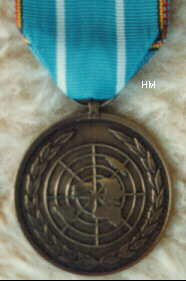

Specific swords with the Chivalry Orders
Crossed swords with a little planchet mentioning "Korea" or "Coree" were instituted for attachment on chivalry orders' ribbons. See : Belgian Orders with swords |
The statutes of this decoration were amended in order to enable it to be awarded for the Korean conflict as an individual or collective bravery award. For a Citation by the Ministery of National Defence a bronze palm was attached to the ribbon. At first this palm bore the royal monogramme consisting of 2 letters "L", the last one mirrored on the first one, with "III" in between them (Leopold III). On 26 November 1952 this was changed into a single letter "L". |
 |
 |
 |
This bronze medal was instituted on 26 September 1951 and it was decreed that a bronze bar with the name of the foreign theatre of operations for which it was awarded should be worn on its ribbon. Recipients are Belgians or foreigners serving in Belgian units serving in foreign theatres of operations. "HAKTANG-NI" for the battle at that place in October 1951 (2nd contingent) and Those wounded during the Korean War wear a red enamelled cross, 5 mm, for each wound received and each individual citation is recognized by a small bronze lion on a round 5mm plaque. |
 |
 |
Instituted 7 April 1952 for volunteers that served "for the duration of the war". Those that volunteered for duty in Korea had a bronze bar "COREE - KOREA" put on the ribbon. Under specific conditions, this medal could be awarded retroactive to both the 1st and/or the 2nd World War and this was indicated with dated bronze bars "1914-1918" and "1940-1945". |
Instituted a day after the previous medal, this merely consists of a bar "PUGNATOR" which is placed on the previous medal's ribbon. In case of an award to a Korean War volunteer for actual combat, a silver "COREE - KOREA" bar is worn over the equally silver Pugnator bar. Under specific conditions, this medal could be awarded retroactively to both 1st and/or the 2nd World War veterans and this was indicated with dated bars "1914-1918" and "1940-1945". |
 |
 |
The United Nations awarded this bronze medal to all who served at least one day in Korea (including the post-armistice period). For Belgians the medal seems to exist only in a French version, having a French reverse text and bar "COREE". |
Members of the United Nations forces in the Korean Conflict normally also received the South Korean War Medal and members of the Belgian Battalion were thus also eligible for it. The original ribbon would have the Korean emblem woven into it but later replacement ribbons no longer do. In some cases, a glazed emblem was then put on the ribbon. |
 |
 |
Copyright Hendrik Meersschaert 2024 ©